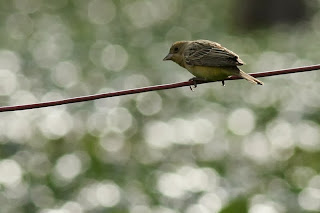We left Ladakh by the only other motorable road. This road leads through the Zanskar area, which is just as marvellous as the previous valleys we visited, and leads in the end to the capital of Kashmir: Srinagar. We spent a couple of days in this disputed area, but remained unfortunately only inside the city. The lake in the city, on which one can sleep in boats (quite expensive though), offers fairly decent birding and we enjoyed our stay there.
Birds observed on the lake included many Indian Pond, Black-crowned Night, Little, Cattle and Great Egret, Common, Pied and White-throated Kingfisher, Black, White-winged and Whiskered Tern, Citrine Wagtail and Clamorous Reed Warbler. The biggest surprise however was a 1kj Red-headed Bunting male in between a dozen of House Sparrows. The yellow rump was seen well and it also had a red-brown hue on the head, excluding Black-headed Bunting.
 |
| 1kj male Red-headed Bunting (Emberiza bruniceps). Note the reddish hue on the head and the still very fresh plumage. |
 |
| Common Kingfisher (Alcedo atthis) |
 |
| White-throated Kingfisher (Halcyon Smyrnensis) |
.jpg) |
| Pied Kingfishers (Ceryle rudis) |
I hope I can come back to this disputed area to try for the three endemics. I regret I did not have time to search for them during this trip, so I highly recommend that people visiting Ladakh, don´t forget to give Kashmir a try, because the people here are very nice and we had no problem at all during our stay and the birds here included some endemic and mythical species! The best trip would be of course to start in the Great Himalayan National park for Western Tragopan and Cheer Pheasant, than go to Ladakh and finish in Kashmir with an Orange Bullfinch. We keep dreaming!












.jpg)